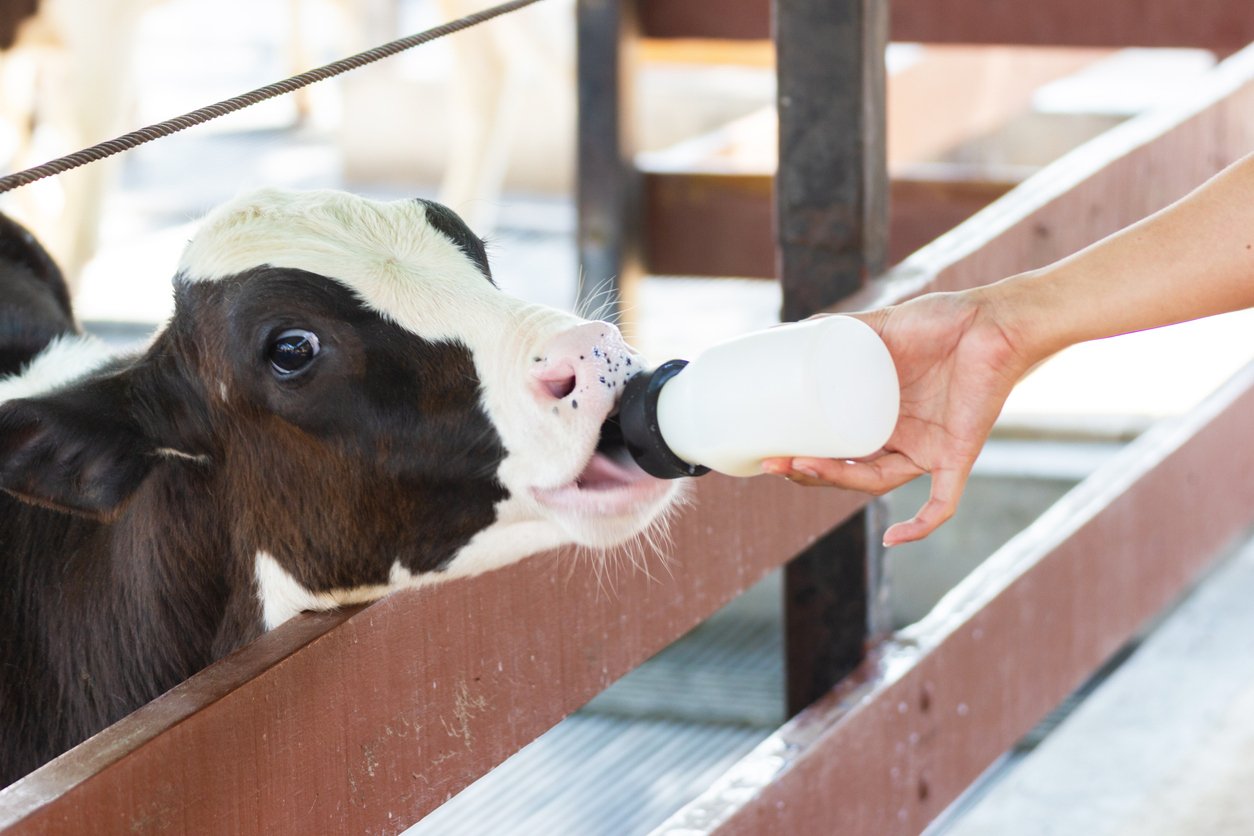Introduction
Colostrum replacers for calves provide essential immunity and nutrition for newborn calves when maternal colostrum is unavailable or insufficient; their prolonged usage is also beneficial to prevent and alleviate common calves' diseases.
Colostrum intake is one of the most critical factors influencing the health and survival of newborn calves in the first two months of life.
When colostrum transfer is compromised—due to delayed intake, low IgG levels in the dam’s colostrum, or a weak calf—alternative solution must be implemented to meet the calf’s immunological and nutritional needs.
When administered correctly, colostrum replacers can ensure effective passive transfer of immunity while minimizing the risk of pathogen transmission. They are also valuable tools in reducing the incidence and impact of early-life infectious diseases in calves.
Prefer to listen to this article? Click the play button below and enjoy our podcast!
What is a colostrum replacer for calves?
A colostrum replacer is a formulated product that replicates the key components of natural maternal colostrum to ensure newborn calves receive vital immunity and nutrition.
These products are specially designed to mimic the essential properties of natural colostrum and serve as the only source of early nutrition when needed. They provide:
- Immunoglobulins (IgG) for passive immunity
- Energy and lipids to support thermoregulation and metabolism
- Growth factors to promote gut development
- Vitamins, minerals, and trace elements essential for early development
Colostrum replacers are typically derived from pooled heat-treated bovine colostrum or from bovine serum or plasma. Unfortunately, they are not available in all countries.
Colostro replacers are different from colostro supplements, less expensive, with a lower Ig content and nutritional value, designed to be fed in conjunction with colostrum collected on farm, when its quality is insufficient.
Is anything better than a dam’s colostrum?
While high-quality maternal colostrum remains the gold standard, colostrum replacers offer safe, standardized immunity when natural colostrum is unavailable or risky.
Colostro-replacers provide key guarantees such as:
- Standardized amount of IgG: ≥100g IgG per dose
- Biosecurity: absence of contamination by infectious diseases (Mycobacterium avium subspecies paratuberculosis (MAP), responsible for Johne’s disease, Mycoplasma bovis…)
However, they may not provide protection to farm-specific pathogens.
The amount of absorbable IgG in colostrum replacers determines whether calves achieve effective passive immunity comparable to that from natural colostrum.
When containing sufficient absorbable IgG to effectively mimic colostrum, colostro replacers can achieve successful passive transfer (Quigley 2001, Pithua et al 2010).
However, when colostrum replacers are fed according to standard recommended protocols—which are often more affordable but involve lower volumes or concentrations, they may not be as efficient as high-quality maternal colostrum in achieving passive immunity (Shivley et al., 2018).
So yes—nothing beats excellent maternal colostrum, but colostrum replacers are often better than poor-quality or risky colostrum.
When do we use colostrum replacer for calves?
Colostrum replacers are used immediately after birth—and sometimes beyond the first feeding—to secure early immunity and support calf health during the neonatal phase.
Essential in the first two hours of life for a healthy start, several promising studies have also investigated the benefits of extended colostrum replacer intake—beyond the first feeding—for improving calf health and development.
Chamarro et al (2017) found that colostrum replacer supplementation of the milk replacer ration for 14 days was effective in reducing antibiotic therapy and occurrence of disease during the pre-weaning period.
Cantor et al.(2021) demonstrated that nutraceutical intervention with bovine colostro replacer reduces the incidence and severity of BRD in calves.
Carter et al (2022) showed that feeding colostrum replacer to pre-weaned calves with naturally occurring diarrhea shorten the duration of illness, improved fecal score and reduced antimicrobial use compared with supportive therapy alone.
STC = Short term colostrum supplementation: 2 days
LTC = Long term colostrum supplementation
Colostro replacer can function as more than just colostrum substitute at birth and can also:
- Reduce morbidity, antimicrobial use and mortality
- Serve as therapeutic agent, improving resilience against enteric and respiratory disease.
Take-home messages:
- Colostrum replacers for calves are a valuable replacement of dam’s colostrum, while avoiding any risk of contamination or disease transmission.
- Colostro replacers offer convenience and consistency.
- Colostro replacers can function as preventive and therapeutic tool to address neonatal pathologies.
References
Pithua, P., S. M. Godden, J. Fetrow, and S. J. Wells. 2010. Effect of a plasma-derived colostrum replacement feeding program on adult performance and longevity in Holstein cows. J. Am. Vet. Med. Assoc. 236:1230-1237.
Quigley, J. D., R. E. Strohbehn, C. J. Kost, and M. M. O'Brien. 2001. Formulation of colostrum supplements, colostrum replacers and acquisition of passive immunity in neonatal calves. J. Dairy Sci. 84:2059-2065.
Cantor MC, Renaud DL, Costa JHC. 2021. Nutraceutical intervention with colostrum replacer: Can we reduce disease hazard, ameliorate disease severity, and improve performance in preweaned dairy calves? J Dairy Sci 104:7168-7176.
Carter HSM, Steele MA, Costa JHC, Renaud DL. 2022. Evaluating the effectiveness of colostrum as a therapy for diarrhea in preweaned calves. J Dairy Sci 105:9982-9994.
Chamorro MF, Cernicchiaro N, Haines DM. 2017. Evaluation of the effects of colostrum replacer supplementation of the milk replacer ration on the occurrence of disease, antibiotic therapy, and performance of pre-weaned dairy calves. J Dairy Sci 100:1378-1387.
Shivley CB, Lombard JE, Urie NJ, Haines DM, Sargent R, Kopral CA, Earleywine TJ, Olson JD, Garry FB. 2018. Preweaned heifer management on US dairy operations: Part II. Factors associated with colostrum quality and passive transfer status of dairy heifer calves. J Dairy Sci 101:9185-9198.
About the author
Brigitte Trezzani (Ruminants Global Technical Manager)
Graduated from Nantes Vet School in 2003. 2 years in mixed practice. Heath management and marketing master. Several experiences in veterinarian pharmaceutical industry, especially in Ruminant vaccines. Huge interest in infectiology and immunology. Dedicated to meet farmers and vets needs concerning infectious diseases and their management, their prevention, either medical or not medical.
Explore author’s articles



Leave your comments here